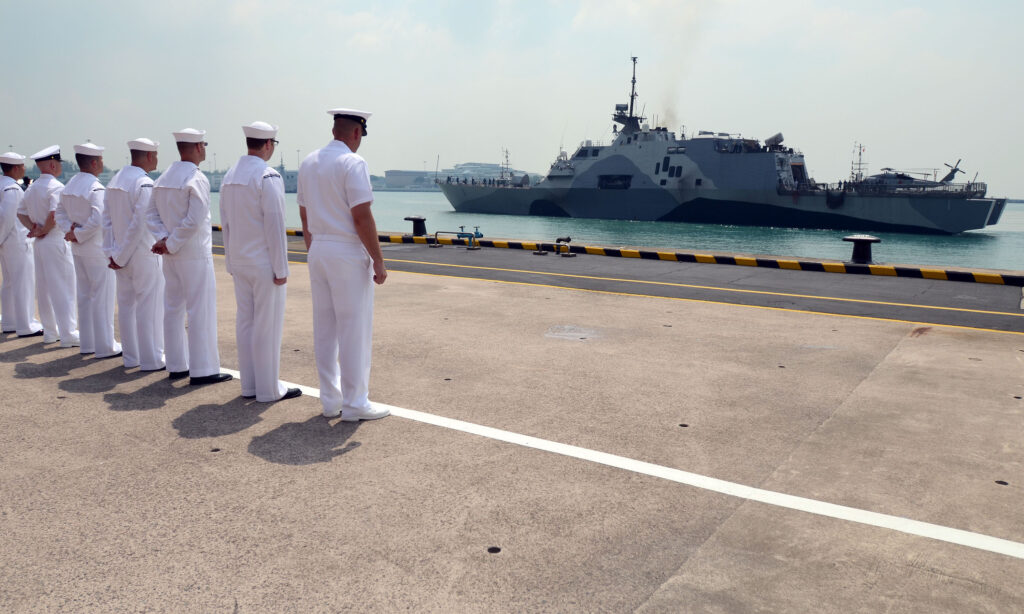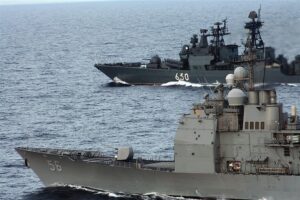Navy’s Dilemma: What Kind Of Presence?
Posted on

The Littoral Combat Ship FREEDOM pulls into Singapore, an increasingly important partner in the Pacific.
WASHINGTON: “I guess I’m going to have to attack your question on almost every aspect,” Adm. John Richardson told me.

Adm. John Richardson
As an analyst, it’s unnerving to have the Navy’s top admiral tell you to your face, albeit politely, that you’re just plain wrong. (I’d politely disagree, though I did miss some important nuances in an earlier story). I had asked the Chief of Naval Operations about the service’s shift in emphasis from providing global presence in peacetime to preparing for high-end warfare. He countered that there really wasn’t a fundamental shift.
Indeed, after a harsh memo from Defense Secretary Ash Carter told the Navy it was spending too little on powerful warships and too much on smaller ships for presence, Navy leaders are at pains to emphasize that presence still matters — none more than Secretary Ray Mabus.
“The most important accomplishment that we’ve had in the almost seven years that I’ve been here and for the Navy’s future is our continuing ability to provide presence,” Mabus told the Surface Navy Association last week. “[It] reassures our allies and deters adversaries. There is no next best thing to being there.”

Navy Secretary Ray Mabus
The secretary brings to mind that great strategic thinker, Woody Allen: “80 percent of life is showing up.” But what you show up with and what you do with it is important too. Presence is still crucial — but not all presence is created equal. (This is the nuance I’d missed earlier). Presence to deter, say, pirates requires very different ships from presence to deter Russia or China. Navy intellectual and financial capital are shifting towards the high-end threat.
“Folks, our job is to kill people and break their toys,” the Navy’s director of surface warfare, Rear Adm. Peter Fanta, said to laughter and applause at the Surface Navy Association’s annual conference. “There’s nothing else in the world that matters. That’s why you have a Navy.”
“I got it,” Fanta went on. “There’s presence — [but] presence without lethality is impotence.”
Foremost among those shifts is Carter’s memo truncating the light-weight Littoral Combat Ship in favor of upgrading destroyers, attack submarines, and strike fighter squadrons. Close on that memo’s heels came “A Design For Maintaining Maritime Superiority” from the new Chief of Naval Operations, Adm. Richardson, which stressed the need to enhance warfighting.
The coincidence in timing — and very different emphasis from preceding Navy strategy documents — colored how commentators, myself included, interpreted Richardson. It is undeniable that the word “presence” doesn’t appear once in the eight-page document; but, Richardson argued forcefully, the concept still does.
“I spent a fair amount of time talking about not just combat but also operations [in general],” Richardson said at a media roundtable during the SNA conference. “The Navy must be able to win in any kind of combat, whether that’s high-end or low-end, but the Navy does so much more for the United States than just combat.”
“Expand and strengthen our network of partners” at home and abroad — training them, reassuring them, responding to their natural disasters — is one of the top four priorities in Richardson’s “Design.” How much higher could it get?, he asked. (The other three are “strengthen naval power” — effectively, warfighting; “accelerate high velocity learning” — training; and “strengthen our Navy team” — human capital).
What about Richardson’s several approving citations of Alfred Thayer Mahan, a naval strategist famed for his focus on decisive battles? “In your nice article on the ‘Design’ you talked about Mahan,” the CNO told me. “You’re in good company: Mahan’s very well known for that operational level, the great fleet battle at sea, [but] I was sort of talking about him at a strategic level, [where] Mahan talks about this very powerful concept of maritime power[:] its quintessential purpose is to provide access to routes for prosperity, access to markets, access to ports.” Warfighting power matters only in service to that grand strategic goal.
“It’s a logical trap to try and describe a navy in terms of one dimension — presence or posture, capability or capacity,” Richardson said. “The nation expects rightly so for us to deliver a navy that balances both of those.”
“I try as much as I can to deflect those either-or type structures, because it’s really both-and,” Richardson said. “Does the needle move from budget cycle to budget cycle? Certainly.”
So why and where is the needle moving?

US and Russian warships
What Kind Of Presence?
“CNO Richardson is trying to thread a needle, carefully,” said retired destroyer captain Bryan McGrath, deputy director of Hudson Institute’s Center for American Seapower. “He recognizes that OSD [the Office of the Secretary of Defense] is uninterested in ship numbers — which serve among other things to enable presence — while his boss in the Navy, Secretary Mabus, is very interested in ship numbers.”
The Navy is changing course, said retired commander Bryan Clark, once a top aide to the previous Chief of Naval Operations, Adm. Jonathan Greenert, and now a senior fellow at the Center for Strategy and Budgetary Assessments. After the Budget Control Act (aka sequestration) began cramping Navy funding in 2013, Clark said, Adm. Greenert and Sec. Mabus decided to keep building ships as fast as possible, at the price of slowing the deployment of new capabilities. Research and development on new technologies continued, however, to keep open the option of upgrading the ships later.

Bryan Clark
“The emphasis,” said Clark, “was clearly on sustaining as much capacity as possible, while maintaining the ability to ramp up new capability when resources became available.”
Today, Clark continued, “Adm. Richardson and SECNAV [Mabus] are faced with the same fiscal situation — less resources than planned and less than what is needed to support today’s fleet size. They could continue down the same path and sustain as much capacity as possible while fielding new capabilities in limited numbers. That approach, however, had reached its limit for several reasons.”
The good: As Mabus proudly notes in every speech, naval shipbuilding has recovered from its nadir under George W. Bush, with two attack submarines, two destroyers, three Littoral Combat Ships, and a few other vessels of various types being bought per year. So the sense of a crisis in fleet size has faded, at least inside the Pentagon. (GOP debates are another matter).
The bad: As Clark wrote in a recent study, the pace of presence deployments has begun to grind down the fleet. There’s an insatiable demand from theater combatant commanders (COCOMs), particularly for “Building Partnership Capacity” (BPC) and “Theater Security Cooperation” (TSC) missions to bolster local partners, primarily in low-threat areas. No achievable increase in the size in the Navy can meet this demand.
The ugly: As Defense Secretary Carter and his deputy Bob Work emphasize over and over, Russia, China, and their arms-export customers are becoming more lethally capable every year. That is increasing the pressure to upgrade our capabilities in areas such as electronic warfare, ballistic missile defense, submarine-launched missiles and more.
“The least risky way to pay for that was LCS,” Clark concluded. Yes, the relatively affordable Littoral Combat Ship is crucial to make up fleet numbers, particularly in the “small surface combatant” category — in essence, ocean-going ships lighter than destroyers, such as frigates and corvettes. But the Navy has been short on such small ships for years, Clark noted, and it’s always found work-arounds, such as the increasing use of supply ships and other auxiliaries for presence missions in low-threat areas.
So, Clark said, Carter and his staff are “willing to live with a continued small combatant shortfall” — even if it does compromise global presence.
Clark’s CSBA colleague Robert Martinage, former Navy undersecretary, put it this way: “I think there’s some concern in OSD [Office of the Secretary of Defense] that — albeit at the request of the COCOMs — the Navy has been focused too much on presence for presence sake (aka BPC/TSC engagement) and not enough on preparing for projecting power, including in contested environments. The LCS becomes a lightning rod in that debate because while it is very useful for the former, it offers comparatively little for the latter. ”

Robert Martinage
“Forward presence is, of course, critical to warfighting,” Martinage said, echoing CNO Richardson and Sec. Mabus. “Forward presence deters adversaries, reassures allies, and in the event that deterrence fails, allows the Navy to project power quickly in defense of the nation’s interests.” But the type of forward presence that can serve those ends, Martinage continued, “needs to be distinguished from activities focused on Building Partner Capacity (BPC) and Theater Security Cooperation (TSC).”
A Littoral Combat Ship or even an unarmed auxiliary can undoubtedly train with allies, conduct port visits, do search and rescue missions, and patrol peaceful waters. When its “mission modules” are in service, the LCS will also be to clear mines, hunt submarines, or shoot up fast attack boats, albeit not all three at once. But even after it’s upgraded with a long-range anti-ship missile (one of Rear Adm. Fanta’s top priorities), it will never have the offensive nor defensive combat power of an destroyer, which can strike targets hundreds of miles inland with Tomahawk cruise missiles or provide Aegis missile defense for friendly ships and land bases.
You can be present in four times as many places with the cheaper LCS — under $500 million per ship — than with the more powerful destroyer — which costs more than $2 billion. But in high-threat theaters, against adversaries with arsenals of long-range missiles, that single destroyer is much more of a deterrent.
As much as Navy leaders seek balance, Carter’s memo is telling them bluntly that their investments are “unbalanced.” As much as Navy leaders argue warfighting and presence are complementary, not in conflict, they still have to decide which gets how much in a tight budget. The 2017 budget submission — and the year-long fight that follows — will just be the beginning of the battle.
Subscribe to our newsletter
Promotions, new products and sales. Directly to your inbox.
